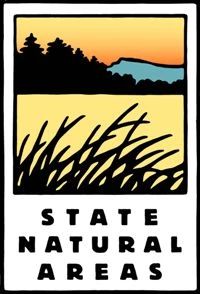White River Boreal Forest
No. 670

White River Boreal Forest natural area supports good quality boreal forest and mesic floodplain terrace communities that help maintain a critical connection between Bibon Swamp and White River Breaks State Natural Areas and the Bad River Reservation. The boreal forest occurs on the narrow ridge-tops and steep clay slopes situated along the White River and is one of the finest examples of this type outside the immediate Lake Superior area. Numerous rare plants and animals are present including the black-billed cuckoo, Cape May warbler and wood thrush. Along the streamside terraces is a mesic floodplain forest with many southern species present. Characteristic canopy trees are sugar maple, basswood, green ash, and white spruce. The ground flora includes cut-leaf toothwort, Virginia spring beauty, yellow trout lily, Dutchman's breeches, and false rue anemone. White River Boreal Forest is owned by the DNR and was designated a State Natural Area in 2013.
Very few State Natural Areas have public facilities, but nearly all are open for various recreational activities as indicated below. Generally, there are no picnic areas, restrooms, or other developments. Parking lots or designated parking areas are noted on individual SNA pages and maps. Trails, if present, are typically undesignated footpaths. If a developed trail is present, it will normally be noted on the SNA map and/or under the Maps tab. A compass and topographic map or a GPS unit are useful tools for exploring larger, isolated SNAs.
The good majority of SNAs are isolated and have few or no facilities. Some SNAs have vehicle access lanes or parking lots, but their accessibility may vary depending on weather conditions. Parking lots and lanes are not plowed during winter. Hiking trails may be nonexistent or consist of undeveloped footpaths. A GPS unit or compass and a detailed topographic map are useful tools for exploring larger SNAs.
Entrance fees: Except for Parfrey's Glen, the Cambrian Outlook in the Dells of the Wisconsin River, SNAs within State Parks and some within State Forests, all other DNR-owned SNAs do not have any admission fees. For more information, see Wis. Admin. Code NR 45 [exit DNR]. For non-DNR-owned SNAs, we are unaware of any vehicle or admission fees. However, please contact the landowner for more information.
ALLOWABLE ACTIVITIES: DNR-OWNED LAND
The activities listed below are generally allowed on all DNR-owned SNA lands. Exceptions to this list of public uses, such as SNAs closed to hunting, are noted above and posted with signs on the property site.
- Hiking
- Fishing
- Cross country skiing
- Hunting
- Trapping
- Scientific research (permit required [PDF])
- Outdoor education
- Wild edibles (What is this?)
- Pets (Rules)
- Wildlife viewing
PROHIBITED ACTIVITIES: ALL SNAS
Although a handful of sites allow activities like primitive camping (e.g. Lower Chippewa River on sand bars) or horseback riding (e.g. S. Kettle Moraine), the activities listed below are generally prohibited on DNR-owned SNAs.
- Camping and campfires
- Collecting of animals (other than legally harvested species), non-edible fungi, rocks, minerals, fossils, archaeological artifacts, soil, downed wood, or any other natural material, alive or dead. Collecting for scientific research requires a permit issued by the DNR
- Collecting of plants including seeds, roots or other non-edible parts of herbaceous plants such as wildflowers or grasses
- Drones: Flying-related activities, including the use of drones, hang-gliders and model airplanes, are prohibited. Permission may be issued by the SNA Program for the use of drones for educational or research purposes.
- Geocaching
- Horseback riding
- Rock climbing
- Vehicles, including bicycles, ATVs, aircraft, and snowmobiles except on trails and roadways designated for their use
For rules governing state-owned SNAs and other state lands, please consult Chapter NR 45 Wis. Admin. Code [exit DNR].
Location
Within the White River Wildlife Area, Ashland County. T47N-R4W, Sections 25, 26, 35. 446 acres.
Driving directions
From Ashland, go south on Highway 13 5.5 miles to the White River. There are no developed parking areas. However, there is a small parking area on the west side of Highway 13 that is often used for canoe takeout for people floating in the river from the west. This parking area can also provide canoe access into the Wildlife Area, however, there is no takeout location on the property, so a return trip is necessary. To access the Wildlife and Natural Area north of the river from Ashland go south on Highway 13 5.3 miles, then east on Hagstrom Road 0.5 miles. Walk south into the site. There is no parking area along Hagstrom Road and road conditions vary seasonally, so walk-in access from Hwy 13 is advised.
The DNR's state natural areas program is comprised of lands owned by the state, private conservation organizations, municipalities, other governmental agencies, educational institutions and private individuals. While the majority of SNAs are open to the public, access may vary according to individual ownership policies. Public use restrictions may apply due to public safety, or to protect endangered or threatened species or unique natural features. Lands may be temporarily closed due to specific management activities. Users are encouraged to contact the landowner for more specific details.
The data shown on these maps have been obtained from various sources, and are of varying age, reliability, and resolution. The data may contain errors or omissions and should not be interpreted as a legal representation of legal ownership boundaries.
To create your custom map where you can zoom to a specific location, please use the DNR's mapping application.
White River Boreal Forest is owned by: Wisconsin DNR
